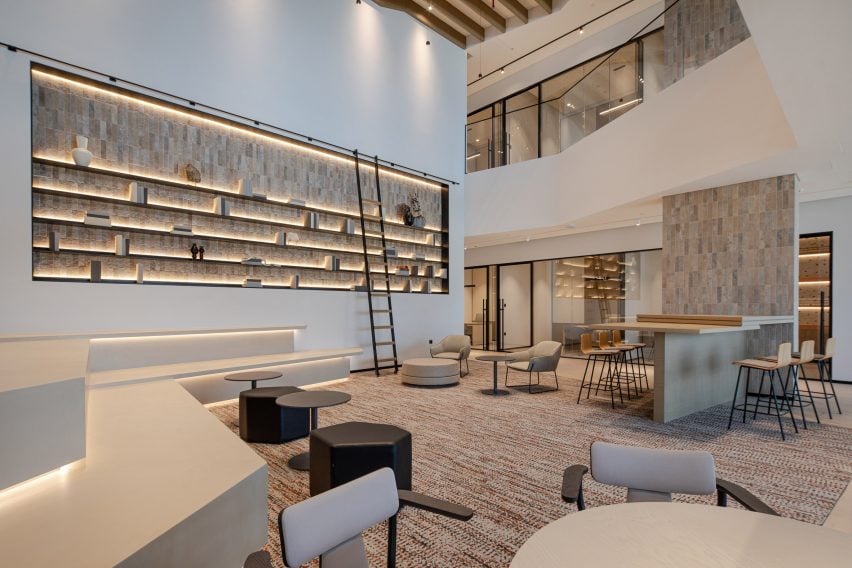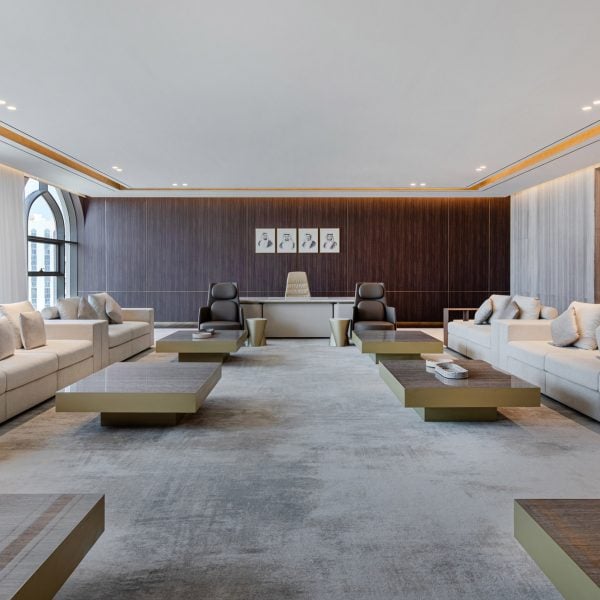Design studio Roar aimed to create a “world-class government building” for Ajman Ruler’s Court in the UAE, which holds the office of Sheikh Humaid bin Rashid Al Nuaimi.
The design was intended to showcase both the heritage of Ajman – the smallest of the seven United Arab Emirates – and its contemporary culture.

“When designers think about the UAE they think bling: gold chandeliers and shiny marble,” Roar founder Pallavi Dean told Dezeen.
“If you take the time to scratch the surface it will reveal layers of character and rich cultural stories, all conveyed in a very modern, non-pastiche language. I hope this project and the government’s bold vision showcases just that.”
The studio was asked to create a design that would encourage collaboration between different government departments while increasing engagement and productivity.
To do so, it created a layout for the two-storey building that drew partly on the geography of Ajman itself.
“First, we redefined the interior architecture by creating three large double-volume spaces,” Dean said. “These voids served as interconnecting volumes that connected the floors both visually and physically.”
“Second, we planned the space like mini districts within the emirate itself – each boasting a variety of workspaces for seated, standing and deep work, complete with flexible meeting areas and a ‘local’ cafe,” she added.
The Ajman Ruler’s Court contains the office of Sheikh Humaid bin Rashid Al Nuaimi – ruler of Ajman, as well as meeting rooms, a boardroom and a reception, with a staircase informed by sand dunes at its centre.
“The staircase represents the fluidity and resilience of our region’s natural landscapes and mirrors the adaptability required in leadership and governance,” Dean said.
In another geographical reference, she designed the ceiling of the stairwell as a nod to a local type of boat.
“Ajman’s port is one of the major contributors to the emirate’s economy,” Dean said. “The traditional dhow, a sailing boat, inspired the architectural forms that you see in the ceiling of the main stairwell.”
The staircase was also decorated with an installation of abstracted palm trees by Emirati artist Khalid Shafar as well as geometric shapes.
“The striking angular forms you see here are reinforced in the space planning and interior elements,” Dean said. “These angles reference back to the shape of the emirate itself on a satellite map.”
The design language of the staircase was echoed in the reception area, which features a pale colour palette and artworks by local artists Akil and Azza Al Qubaisi.
Here, visitors can also admire the Sheikh’s elevator, which draws on the architecture of traditional Areesh houses made of palm trees and features brass panels and wood details.
Dean used texture and forms to demarcate the different areas of the Ajman Ruler’s Court while keeping the colour scheme fairly consistent.
“The space is predominantly monochromatic in terracotta tones – we used varying texture, played with the lighting and geometric forms in the ceilings to distinguish different areas,” she explained.
“Vernacular pattern that has been abstracted features on wall cladding and screens that divide the space.”
In Sheikh Humaid bin Rashid Al Nuaimi’s office, Roar used neutral tones and added an artwork by Ultra Arte that was specially created for the space.
The boardroom, meanwhile, features a stainless-steel artwork informed by the Al Barwa letters that were traditionally written by UAE rulers and dignitaries.
Roar also designed the Chairman’s Majlis, a meeting room furnished with low sofas. Here, wood panelling, marble-topped tables and soft carpeting create a tactile feel, while a glass chandelier adds a playful design detail.
Dean hopes that Ajman Ruler’s Court will be appreciated as a well-designed building, not just on a local but on a global scale.
“This building sends a message about the future of Ajman and its values – so people should think ‘Wow, this is one of the best government buildings in the UAE… no wait. Globally!’ – only the visitor can be the judge if we have truly delivered that!” she concluded.
“That’s the aspiration – we wanted to deliver a world-class government building.”
Other recent projects by Roar include a showroom for Jaipur Rugs in Dubai that features cascading staircases and a cafe with decorative broken ceramic tiles.
The photography is by Yasser Ibrahim.
link

